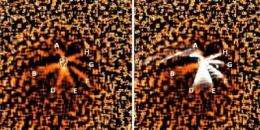Where comets emit dust

Studying comets can be quite dangerous - especially from close up. Because the tiny particles of dust emitted into space from the so-called active regions on a comet's surface can damage space probes.
Scientists from the Max Planck Institute for Solar System Research in Germany have now developed a computer model that can locate these regions using only the information available from Earth. The new method could help calculate a safe flight route for ESA's space probe Rosetta, which is scheduled to arrive at the comet Churyumov-Gerasimenko in 2014. (Astronomy & Astrophysics, 512, A60, 2010)
A comet's nucleus is much more than an unvarying chunk of ice and dust. Under the Sun's influence, volatile substances such as water, carbon dioxide, and carbon monoxide are emitted from certain regions on its surface - the so-called active regions - carrying dust particles with a diameter of up to a few centimetres into space. Seen from Earth, these fountains of dust can be discerned as jets or spiral arms that surround the comet (see figure 1). These structures are embedded in a sheath of gas and dust called the coma that is produced by the more uniform activity of the overall surface.
"Pictures taken from Earth show the comet and its jets as a two-dimensional projection", explains Hermann Böhnhardt from the Max Planck Institute for Solar System Research (MPS). Where exactly the dust particles and gases originate from can not therefore be well identified.
In order to localize the active regions despite this problem, the MPS-researchers chose an indirect approach that for the first time also accounts for the three dimensional shape of the comet. "Until now, computer programs trying to find the active regions assumed the comet as a sphere or ellipsoid", explains Jean-Baptiste Vincent from MPS. Since in reality comets often have quite bizarre shapes, for many applications this approach is not good enough. The researchers therefore decided to take a standard approach: While watching a comet for an entire rotation period, changes in its luminance allow its true form to be calculated.
In a next step, the researchers fed their program with an initial assumption where the active regions might be located. Additionally they made an "educated guess" concerning the physical properties of the dust particles like size and initial velocity upon emission from the nucleus. As a result, the computer simulation delivers an image as it would be seen through a telescope on Earth. By comparing this with the actual image through a telescope the model can be refined step by step until simulation and actual image agree.
Already, the new method has passed its first test: The scientists could successfully apply it to the comet Tempel 1 that was the destination of NASA's Deep Impact Mission in 2005. "Even though ever since this mission we know where Tempel1's active regions are, we pretended not to", explains Vincent. For their computer program the scientists only used information that was available from Earth-base observations - apart from the nucleus shape model that was adopted from the mission results.
Next, the researchers intend to calculate the active regions of the comet Churyumov-Gerasimenko, the rendezvous target for ESA's Rosetta mission on which the Rosetta lander Philae will touch down in late 2014. The mission, to which MPS contributed many scientific instruments, has been on route to its destination beyond the orbit of Mars and the asteroid belt since 2004. In the crucial phase of the mission, the new method could help to determine a safe route for Rosetta through the cometary coma and maybe even find a suitable landing site.
More information: J.-B. Vincent, H. Böhnhardt, and L.M. Lara, A numerical model of cometary dust coma structures - Application to comet 9P/Tempel 1, Astronomy&Astrophysics 512, A60 (2010) DOI: 10.1051/0004-6361/200913418
Provided by Max-Planck-Gesellschaft



















